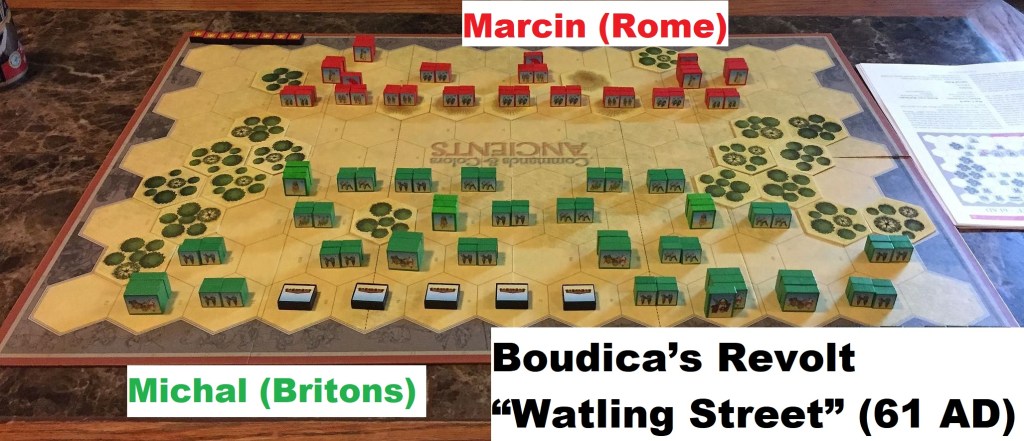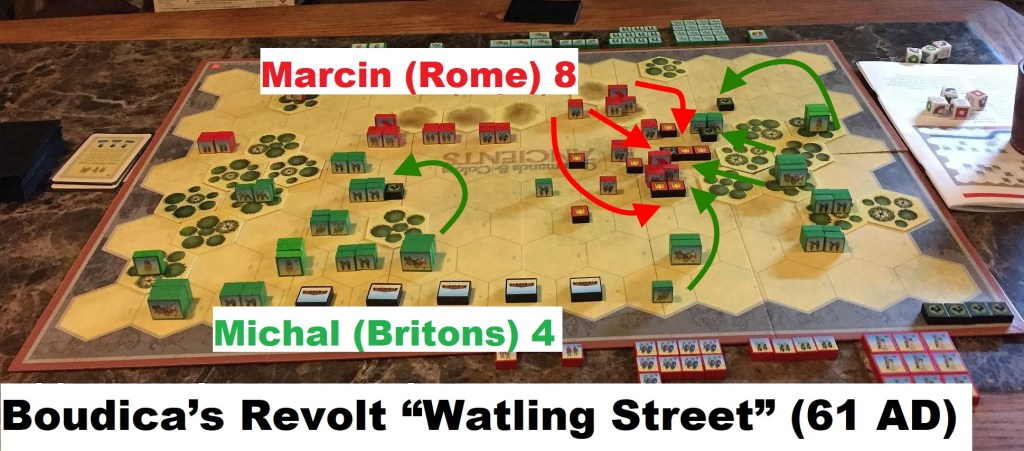I will continue today the mini-campaign which I was playing with Marcin using C&C Ancients and depicting the Roman conquest of Britain. The first part, where we played initial 3 scenarios, can be found here: Roman conquest of Britain using C&C Ancients – Part 1.
Just a reminder: the idea was to play C&C Ancient scenarios featuring the Romans battles in Britain, combining them in mini-campaign. There is a special map created to depict the locations, each engagement has a historical introduction, they are played in chronological order so the flow of history unfolds nicely and connect together. In essence it is not only pure gaming experience but also a historical insight.
Some of my articles regarding C&C system:
Commands and Colors games – my 3 favorite
[REVIEW] Commands Colors Ancients
[STRATEGIES] How to attack in Commands Colors Ancients?
[STRATEGIES] How to defend in Commands Colors Ancients?
The battles which we decided to put on the table were:
- Medway (43 AD) from Expansion 3
- Cefn Carnedd (51 AD) from Expansion 2
- Mona Insulis (60 AD) from C3i #23 magazine
- Camulodunum (60 AD) from C3i #23 magazine
- Boudica’s Revolt “Watling Street” (61 AD) from Expansion 4
- Mons Graupius (84 AD) from Expansion 4
In this article I will describe the latter three (4-6):
Without further delay, let me invite you to the first century AD Britain. First and foremost – Queen Boudica uprising!
Camulodunum (60 AD)
Historical background
While many of the tribes of Britain resisted Rome until they were conquered and crushed, a few tribes, like the Iceni, formed pacts with the Romans to remain semi-independent. The Iceni client-king Prasutagus died while the Roman governor, Gaius Suetonius Paulinus, was campaigning in what is now northern Wales. In Suetonius’ absence, the procurator, Catus Decianus, took advantage of these events to seize lands, recall loans, and generally revoke all the advantages the clients had obtained from Claudius. When Prasutagus’ widow, Boudica, complained, she was flogged and her young daughters raped in front of her. Instead of suppressing dissent these barbarous acts fanned the fires of revolt.
Queen Boudica led her army of rebels, predominantly Iceni and Trinovantes, to Camulodunum. The city had been designated a colony for unruly veterans of the XXth legion, and as Boudica approached the city the statue of Victory fell down for no apparent reason, which fanned the flames of panic. The Romans were so confident that the Britons had been pacified that they built no walls around the city, instead favoring amenities like bathhouses. The small Roman garrison was bolstered by armed veterans and a few men sent by the procurator Decianus. Hopelessly outnumbered, they took refuge in the Claudian temple and hoped to hold out until a relief force could arrive.
The impetuous Quintus Petillius Cerialis with elements of the IXth legion, rushed to the aid of the city, and was ambushed while in march column. The Romans tried to form a line of battle but the Britons were on them before they could form up and were slaughtered. Only Petillius with his cavalry manage to escape.
Session report
We started with first of Boudica revolt scenarios which has an interesting special set-up with small Roman garrison defending desperately in a church (top, let corner) and awaiting the relief from main forces. In this scenario I had possibility to lead Romans against Britons and it was a very bitter experience.
Try as I might, I was not able to save the veterans and the temple fallen. In the center and on my right a bloody, chaotic and desperate fight ensued. Marcin’s chariots were of great mobility and he was able to strike from afar. My legions were much better equipped and were inflicting significant losses when repelling those charges. There was no place for sophisticated tactics, flanking or other maneuvers.
In the end both sides were pretty much exhausted and Marcin’s Britons won the game with last, desperate roll, achieving 1 VP advantage.
Boudica’s Revolt (61 AD)
Historical background
After sacking the legion colony of Camulodunum, defeating several small Roman forces, burning Londinium and Verulamium (St. Albans), and killing as many as 70,000 people Boudica rebellion was on a rise. Roman governor, Suetonius, summoned reinforcements from all over Britain until he was strong enough to fight on a carefully selected defensive position offering a narrow front that would minimize the enemy numbers.
Flushed with success, Boudica’s Celtic host may have numbered as many as 50,000 fighting men, followed by their families and baggage wagons loaded with plunder. She deployed these wagons at the rear of her army. The men would fight all the harder knowing that their families were watching and would be in grave danger if the Romans triumphed. The Britons launched a massive frontal attack. Suetonius held his forces in place.
As the charging Britons neared the Roman line, they were staggered and stopped by a storm of pilum. Only then did the Romans attack the confused Britons, driving them back onto their wagons and cutting them down by the thousands. Boudica managed to escape, but later committed suicide rather than be captured.
Session report
Boudica revolt is spreading – however, new legions and new commanders arrive from Rome and more competent leadership starts to influence the outcome. Hm, let sees if they will manage to beat me!
When you look at the map you will see that this is one of the largest CCA regular scenarios – with 25 units on Britons side. That depicts size of Boudica’s army – but their disposition clearly shows how poorly lead they were. Still, the numbers are far from even – so it is not surprising that legions takes defensive position at the hills.
Hills, yes. They indeed were a very good defensive position but Marcin being constantly harassed by my range fire decided to abandon safety and charge.
The ensuing slaughter – just look at the number of victory banners placed – on Roman’s left / Boucida right truly decided the final result of the game. Both sides were significantly depleted but there was no doubt in imperial victory.
Mons Graupius (84 AD)
Historical background
After years of campaigns in northern Britain, Gnaeus Julius Agricola subdued all the tribes except the fierce Caledonians. Agricola maneuvered to bring the Caledonians to open battle. Determined to restore the security of his Highland home, the Caledonian chief, Calgacus, gathered a strong force of about 30,000 and awaited and the Romans at Mons Graupius. Calgacus occupied the high ground with his main force and posted a line of chariots on level ground to their front. The Roman army was of roughly equal size. Agricola deployed his auxiliary infantry and cavalry in the main battle line and held his legions in reserve.
The battle opened with Agricola’s cavalry charge against the barbarian chariots while the infantry moved forward and engaged in an exchange of missiles with the enemy. When the charioteers began to give ground, the Roman auxiliary infantry closed to hand-to-hand combat, which drove the enemy line back. A desperate attempt to outflank the Roman line was turned back by another cavalry charge. The outcome was considered remarkable because solely auxiliary forces had achieved the victory. Following the battle, Agricola proclaimed that all tribes in Britain had been conquered.
Session report
We are moving 25 years in time and history takes us to the northern Scotland – to Caledonia. Gnaeus Julius Agricola – one of the best Roman generals ever – subdued all the tribes except the fierce Caledonians. He managed to maneuver them into a pitched battle, which was supposed to solidify the Roman hold on this area for centuries.
The battle and set-up looks very balanced – and they really are! Romans have possibility to use heavy legions but need more points then – and Marcin decided (historically) to battle only with auxiliary forces as well as light infantry / cavalry.
That was a fateful decisions which turned into disaster once his leader was dead. This time majority of battle happened on my left / Marcin’s right. And it was a battle of maneuver as both sides had pretty larger cavalry contingents. Unfortunately for Romans, my fierce Caledonians were in their best shape on that evening and won decisively!
Summary
That concluded our 6 scenario, mini-campaign. We played with great pleasure, having fun both from gaming experience but also reenacting history. We also tallied the scores:
- Michal 30– Marcin 30 (unbelievable! a draw)
- Britons 32 – Romans 28 (surprisingly, Britons won with minor advantage)
That was a very close campaign we finished – both for our individual scores but also for Romans vs Britons. The island will become a constant places of unrest in the Empire and in the end – first province to detach from that great political entity.
More session reports to come!









Loved this!! Such a great report!
I need to replace the blocks with minis but inspirational stuff!
LikeLiked by 1 person
Thanks! Those were one of the most hard-fought battles!
LikeLiked by 1 person
Good report!
LikeLiked by 1 person
Thank you! If you are interested, there are many more on my page!
LikeLike